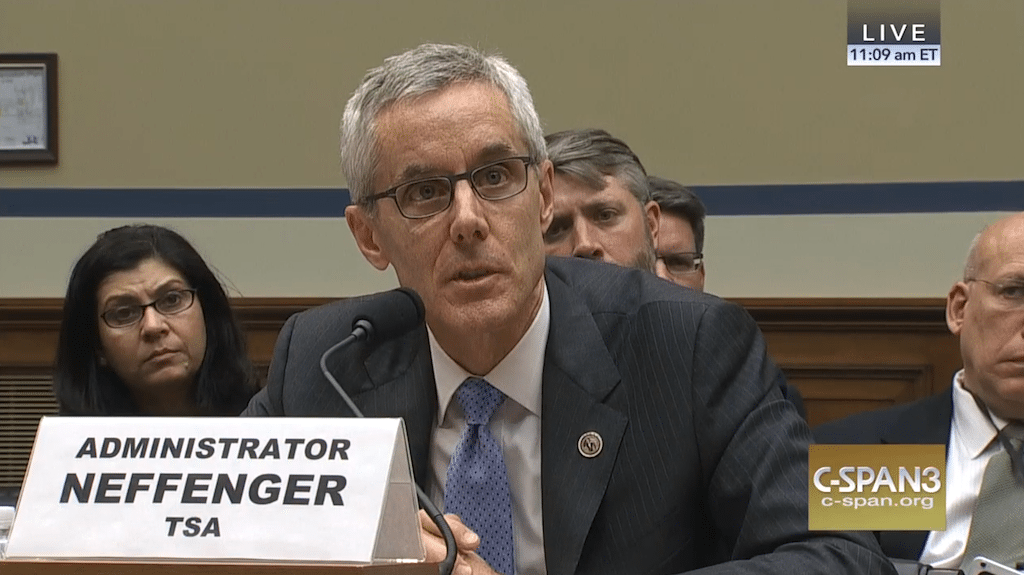Skift Take
Finger-pointing continues over the security line debacle at U.S. airports.
Members of the United States House of Representatives questioned Transportation Security Administration (TSA) administrator Peter Neffenger once again on Thursday, this time tying reports of internal misconduct to the current staffing breakdown that is affecting flyers across the U.S.
Neffenger put the blame on incorrect passenger growth predictions when asked about the cause of the current TSA security line delays, disputing claims that the line slowdowns have to do with a lack of funding.
“I have not said it’s a lack of funds [that has caused the delays],” said Neffenger. “… We have a significantly larger population of travelers this year than we have had previously and it has grown substantially. It grew faster and at a higher rate than predicted by those who set the predictions…
“When I came into this organization last year, I found an organization with 5,800 fewer screeners than it had had four years previously in the face of higher traffic volume. The first thing I did was ask Congress to was to halt any further reductions to the workforce because it was my suspicion we did not have enough people to staff the lanes.”
Neffenger said the current situation is essentially the result of plans made by previous TSA leaders. The TSA expected two percent passenger volume growth, as predicted by the Bureau of Transportation Statistics (BTS), but the actual growth has been much larger, according to Neffenger’s testimony.
(UPDATE: A BTS representative has reached out to Skift, confirming that the organization “does not make aviation projections of any kind.”)
“I’m sure there were good reasons for people before me to reduce that [number], predicated on predictions of a higher number of people getting into expedited screening,” said Neffenger. “It’s just a fact we’re a small work force on the frontline than we were before, and we have significantly more people moving through the system.”
The current proposal for additional funds being considered in Congress would allow the TSA to add an additional 768 screeners. He expects these security workers to be deployed in the field by the middle of June.
“I think we have a shortage of staff across the system right now,” said Neffenger. “We’re moving people into the areas of greatest volume and greatest need. We are hiring back the people who had been slated to be attrited out this year, and we’re pushing out about 200 more officers each week… we currently cannot staff adequately across the system to peak volume.”
Written testimony from Department of Homeland Security inspector general John Roth paints a particularly scathing picture of the TSA, showing that little to no progress has been made across the board years after security concerns have been identified.
Here are a few lowlights from his submitted written testimony that pulled together information from several TSA audits:
- “Since 2004, we have conducted eight covert penetration testing audits on passenger and baggage screening operations. Last summer, the results of our covert testing of TSA’s Automated Target Recognition Software and checkpoint screener performance was troubling and disappointing.”
- “In June of 2015, we found TSA lacked assurance that it properly vetted aviation workers possessing or applying for credentials that allow unescorted access to secure areas.”
- “According to TSA, since 2009, it had spent $540 million for checked baggage screening equipment and $11 million for training. Despite that investment, TSA had not improved checked baggage screening since our 2009 report on the same issue.”
- “Another recent audit revealed that the safety of airline passengers and aircraft could be compromised by TSA’s inadequate oversight of its equipment maintenance contracts. TSA has four maintenance contracts valued at about $1.2 billion, which cover both preventive and corrective maintenance for airport screening equipment. Because TSA does not adequately oversee equipment maintenance, it cannot be assured that routine preventive maintenance is performed on thousands of screening units or that this equipment is repaired as needed, ready for operational use, and operating at its full capacity.”
The Daily Newsletter
Our daily coverage of the global travel industry. Written by editors and analysts from across Skift’s brands.
Have a confidential tip for Skift? Get in touch
Photo credit: TSA administrator Peter Neffenger. CSPAN
